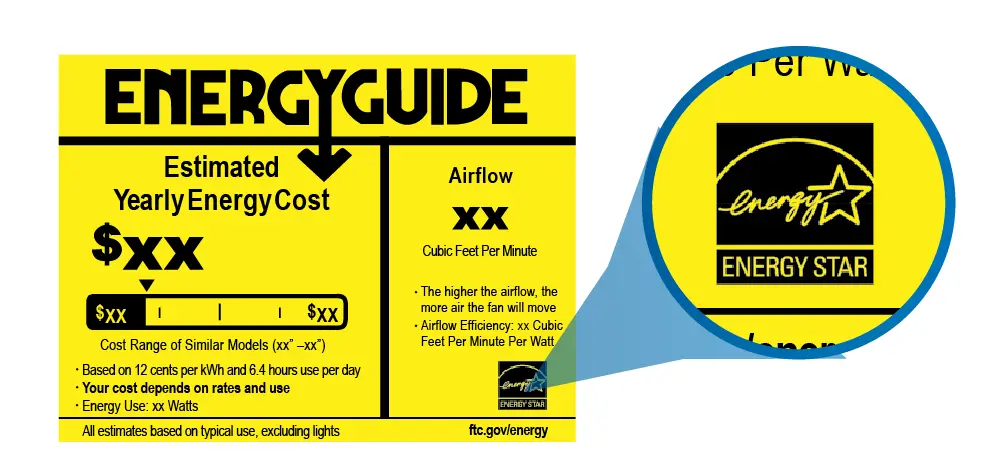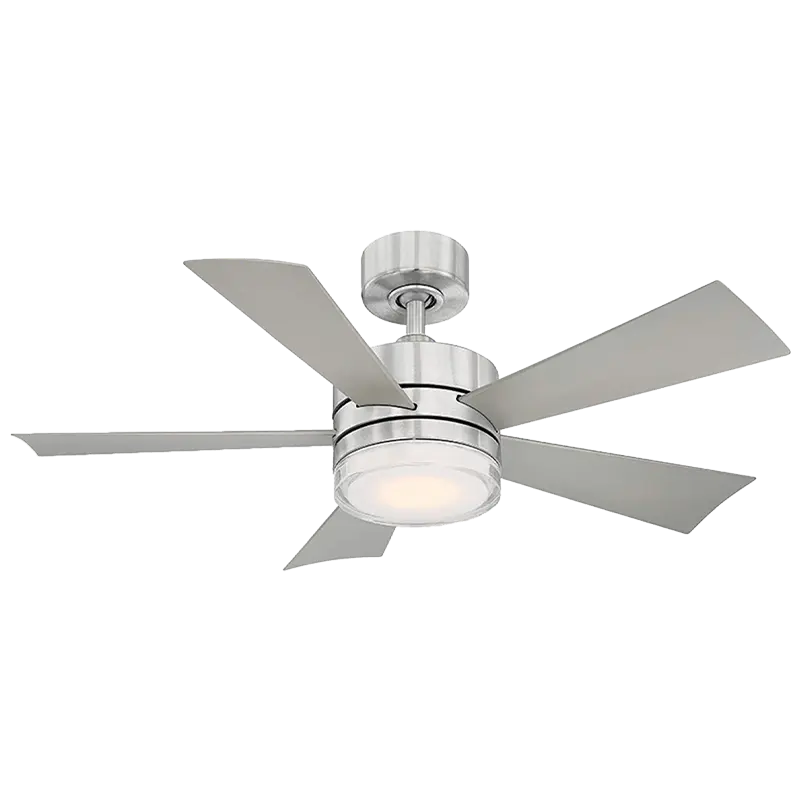There are many ceiling fans available on the market that are EnergyStar-rated and some that aren’t. What does this mean? Why would you need one in the first place?
In this article, we have explained the comparison between Energy Star and regular ceiling fans. So you have less difficulty deciding which fan to buy for better efficiency and performance.
What are Energy Star Ceiling Fans?
Energy Star fans are a good choice if you’re looking for an energy-efficient fan. They use less energy, produce the same amount of airflow as a regular fan, and are also quieter.
They have higher air quality standards than most regular models. This means they can help reduce dust and other allergens that collect in the air with every breath you take.
Performance Differences Between an Energy Star Fan and a Regular Ceiling Fan
According to a study conducted by the U.S. Department of Energy, Energy Star fans use up to 40% less electricity than regular fans, which translates into significant savings on your monthly electric bill.
The way that these fans operate makes them so much more efficient than their opposite counterparts. They operate at slower speeds or turn off when you don’t need them, and they also have blades with smaller diameters and pitch angles (the angle at which each blade meets its hub).
These features combine to make the fan’s energy usage more efficient and cost-effective over time.
Energy Star fans help improve air quality in your home by circulating cleaner air throughout the room without creating too much noise or raising your utility bill unnecessarily!
They use less energy but generate the same amount of airflow
This means you can run your fan for longer hours and still use less electricity than with a regular fan.
Why? Because there’s a lot more to an energy-efficient ceiling fan than just how much power it uses.
Normal motors are designed to spin faster than necessary to create more air circulation; this is inefficient because it wastes electricity by spinning too fast and generating unnecessary heat from friction with its bearings.
Energy Star motors are designed to rotate at slower speeds (usually 1500 RPMs or lower) but produce more airflow per watt of electricity consumed by slowing down their blades as they spin, which preserves energy without sacrificing performance!
They are quieter than regular fans
The first big difference between energy-efficient and standard fans is the quality of their components. Energy-efficient fans tend to use more expensive, high-quality materials that make for quieter operation and less wear and tear on the fan motor and bearings.
What does this mean for you? As a homeowner, you can expect your energy-efficient ceiling fan to be significantly quieter than a regular ceiling fan.
With fewer moving parts than standard fans (including motors, blades, and bearings), an energy-efficient model has less friction during operation—which means it’ll last longer before needing repairs or maintenance work done on it.
This also means there’s less noise from your fan when you turn it on—so no more waking up everyone in the house as soon as summer arrives!
They have higher air quality standards
These ceiling fans help improve your indoor air quality and make you feel more relaxed. They also help reduce ozone emissions by up to 25%.
The high-quality materials used on these fans are beneficial for people with respiratory conditions. This is because they clean the air as the fan circulates it.
Some models even have built-in air filters for your home that remove contaminants from the air as it is circulated by the fan.

Important!
Make sure to look for the ENERGY STAR logo at the bottom right corner of the yellow Energy Guide label to make sure that the ceiling fan is efficient and will save you money.
Regular Fans
Regular fans are the most common type of fans. Because they’re so widely available, regular fans tend to be cheaper than Energy Star ceiling fans.
The average cost of a regular 12-inch-diameter fan is around $15–$30, while the average price tag on an Energy Star model is $100–$150 or more, depending on size and features.
They are usually less effective than certified models because their motors aren’t optimized for high-efficiency use like their counterparts’ are; however, this doesn’t mean that all regular fans are inefficient!
Some Features of Regular Fans
Standard fans operate using traditional technology
Traditional fans are designed to move air in a room. They’re great at doing this, but they’re not so great at saving you money. Because of the way standard fans are designed and manufactured, they don’t have the same energy efficiency as Energy Star models.
Standard fans usually come with three-speed settings: low (slow), medium (medium), and high (fast). Some models also have an oscillating setting so you can move air outwards from your fan instead of just upwards.
They consume 60 to 100 watts of electricity
Most standard fans consume only 60 to 100 watts of electricity, which is significantly less than other appliances in your home. Consider that a microwave oven consumes more than 1200 watts while it’s on and even more when it’s warming up.
A fridge uses around 300 watts. In comparison, a ceiling fan uses about 150-200 watts an hour, depending on usage patterns and the type of motor used for the fan.
It’s not hard to see why there has been such a push towards energy efficiency these days: saving money by using less energy is one of the easiest ways to reduce your carbon footprint at home!
They make more noise than Energy Star fans
Energy star fans are quieter than regular ceiling fans because they feature better motors, which use less electricity and produce less noise.
The newer motors also feature better materials that allow them to run at higher speeds without producing as much friction.
This means that an Energy Star fan can run at lower speeds and still be just as effective as a regular fan made in the same year.
There are other reasons why Energy Star fans tend to make less noise than non-energy efficient ones, but this is usually the main reason people notice when comparing the two types side by side.
Tip!
You should replace any old ceiling fan with a new Energy Star-rated version if you want to save money and make your home more comfortable.
So, What’s The Best Energy Efficient Ceiling Fan?
If you’re looking to purchase an Energy Star-rated ceiling fan, don’t worry! We have picked a fantastic fan that checks all the boxes for efficiency as well as other crucial features that are necessary for any ceiling fan today!
| Electricity Consumption in Watts (W) |
|---|
| Consumption on high speed: 52.4w |
| Consumption on low speed: 6.5w |
| Consumption on standby: 1.4w |
| CFM Efficiency (CFM/W): 184.0 |
Modern Forms Wynd FR-W1801 Smart Ceiling Fan is a feature-packed option that does not compromise energy efficiency. This fan is certified by Energy Star and it is also a part of the amazon climate pledge-friendly program.
Since it is a Wet Rated Listed, we can use it both indoors & outdoors, which makes it an ideal choice for bedrooms, living rooms, kitchens, and outdoor patios & garages.
The fan is available in 3 different blade sizes, which are 42-inches, 52-inches & 60-inches. You also get 5 different color options to choose from according to your needs, as well as 3 different LED light colors, including warm and white LEDs.
The fan has a down rod mount, which makes it quite handy for high ceilings. You can always change the down rod of it for longer if you have a heightened ceiling. The DC motor on this fan makes it almost noiseless, with a sound level of 15 dB.
Since the fan doesn’t compromise on smart features, it works with all the smart home tech, which includes Alexa, Google Home, Samsung Smart Things, and more.
Moreover, it has a dedicated smartphone app from which you can control the fan entirely, including turning it on and off, fan speed control, and light brightness control. It also comes with a long-range battery-operated bluetooth remote control!
Overall, it is an amazing choice if you want an energy-efficient fan and also smart features at the same time.
Looking To Buy A Ceiling Fan? Read Our Guide:
FAQs – Sort out more questions!
What is the most efficient type of ceiling fan?
Energy Star certified fans and light combination units offer optimized air delivery that can save 15%–33% energy and, on average, provide higher air circulation than standard, independently rated fans. These certified fans are one of the most efficient types of ceiling fans.
Are new ceiling fans more energy-efficient?
New fans are more energy efficient as a group than older fans. Energy Star-rated fans use about 10% less energy than the typical non-Energy Star-rated ceiling fans. It’s also important to make sure your fan isn’t set on a higher speed than it needs to be for the conditions you’ve got it in (fan ventilation).
How much energy do fans use?
Ceiling fans use between 15 and 90 watts of energy per hour, depending on the model. Tower fans use around 110 watts per hour. The cost to run a fan 24 hours a day is around $3.80 per year, while the cost to run a tower fan is around $20.67 per year.
Conclusion
Energy Star ceiling fans are quieter, more energy-efficient, and safer than standard models. They have a longer life span and better warranty coverage. The higher quality of their materials means that you get more value for your money than with less expensive alternatives.


